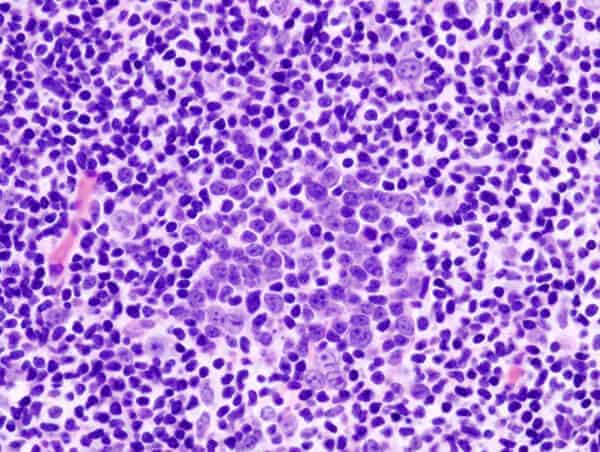- GOYA study did not meet its primary endpoint of improvement in progression-free survival with Gazyva/Gazyvaro plus CHOP chemotherapy versus MabThera/Rituxan plus CHOP chemotherapy
Roche (SIX: RO, ROG; OTCQX: RHHBY) today announced that the phase III GOYA study evaluating Gazyva®/Gazyvaro® (obinutuzumab) plus CHOP chemotherapy (G-CHOP) in people with previously untreated diffuse large B-cell lymphoma (DLBCL) did not meet its primary endpoint of significantly reducing the risk of disease worsening or death (progression-free survival; PFS) compared to MabThera/Rituxan (rituximab) plus CHOP chemotherapy (R-CHOP). Adverse events with Gazyva/Gazyvaro and MabThera/Rituxan were consistent with those seen in previous clinical trials when each was combined with various chemotherapies. Data from the GOYA study will be presented at an upcoming medical meeting.
“Two previous studies showed Gazyva/Gazyvaro helped people with previously untreated follicular lymphoma or chronic lymphocytic leukaemia live longer without their disease worsening compared to MabThera/Rituxan, when each was combined with chemotherapy. We were hopeful we could show a similar result for people with diffuse large B-cell lymphoma and once again improve on the standard of care,” said Sandra Horning, MD, Chief Medical Officer and Head of Global Product Development. “We will continue to analyse the GOYA data to better understand the results, and to study other investigational treatments in this disease with the goal of further helping these patients.”
About the GOYA study
GOYA (NCT01287741) is a global phase III open-label, multi-centre, randomised two-arm study examining the efficacy and safety of the combination of Gazyva/Gazyvaro plus CHOP chemotherapy (G-CHOP) compared to MabThera/Rituxan plus CHOP chemotherapy (R-CHOP). GOYA included 1,418 previously untreated patients with CD20-positive DLBCL. The primary endpoint of the study is investigator-assessed PFS, with secondary endpoints including PFS assessed by independent review committee (IRC), response rate (overall response, ORR; and complete response, CR), overall survival (OS), disease free survival (DFS) and safety profile. The GOYA study is being conducted in cooperation with the Fondazione Italiana Linfomi (FIL, Italy).
About Gazyva/Gazyvaro (obinutuzumab)
Gazyva/Gazyvaro is an engineered monoclonal antibody designed to attach to CD20, a protein expressed on certain B cells, but not on stem cells or plasma cells. Gazyva/Gazyvaro is designed to attack and destroy targeted B-cells both directly and together with the body’s immune system.
Gazyva/Gazyvaro is currently approved in more than 70 countries in combination with chlorambucil, for people with previously untreated chronic lymphocytic leukaemia. The approvals were based on the CLL11 study, showing significant improvements with Gazyva/Gazyvaro plus chlorambucil across multiple clinical endpoints, including PFS, overall response rate (ORR), complete response rate (CR), and minimal residual disease (MRD) when compared head-to-head with MabThera/Rituxan plus chlorambucil.
In February 2016, Gazyva was approved by the US Food and Drug Administration in combination with bendamustine followed by Gazyva alone for people with follicular lymphoma who did not respond to a Rituxan-containing regimen, or whose follicular lymphoma returned after such treatment. In June 2016, Gazyvaro was approved by the European Commission in combination with bendamustine followed by Gazyvaro maintenance in people with follicular lymphoma who did not respond or who progressed during or up to six months after treatment with MabThera or a MabThera-containing regimen. Both approvals were based on the phase III GADOLIN study, showing a significant improvement in progression-free survival with Gazyva/Gazyvaro-based therapy compared to bendamustine alone. Gazyva is marketed as Gazyvaro in the EU and Switzerland.
In May 2016, the phase III GALLIUM study in people with previously untreated follicular lymphoma met its primary endpoint early. GALLIUM compared the efficacy and safety of Gazyva/Gazyvaro plus chemotherapy (CHOP, CVP or bendamustine) followed by Gazyva/Gazyvaro alone, head-to-head with MabThera/Rituxan plus chemotherapy followed by MabThera/Rituxan alone. Results from a pre-planned interim analysis showed that Gazyva/Gazyvaro-based treatment resulted in superior progression-free survival compared to MabThera/Rituxan-based treatment. Adverse events with either Gazyva/Gazyvaro or MabThera/Rituxan were consistent with those seen in previous clinical trials when each was combined with various chemotherapies. Data from the GALLIUM study will be presented at an upcoming medical meeting and submitted to health authorities for approval consideration.
Additional combination studies investigating Gazyva/Gazyvaro with other approved or investigational medicines, including cancer immunotherapies and small molecule inhibitors, are underway across a range of blood cancers.
About DLBCL
Diffuse large B-cell lymphoma (DLBCL) is the most common subtype of non-Hodgkin lymphoma (NHL), accounting for about one in three cases of NHL1. DLBCL is an aggressive (fast-growing) type of NHL, which is generally responsive to treatment in the frontline2. However, as many as 40% of patients will relapse, at which time salvage therapy options are limited and survival is short2. Approximately 123,000 people worldwide are estimated to be diagnosed with DLBCL each year3.
References
1 – Lyon, France: IARC Press; 2008. World Health Organization Classification of Tumors of Haematopoietic and Lymphoid Tissues.
2 – Maurer, JM et al. (2014). Event-free survival at 24 months is a robust end point for disease-related outcome in diffuse large B-cell lymphoma treated with immunochemotherapy. J Clin Oncol 32: 1066-73.
3 – Numbers derived from GLOBOCAN 2012: Estimated cancer incidence, mortality and prevalence worldwide in 2012. http://globocan.iarc.fr. Accessed June 2016.

